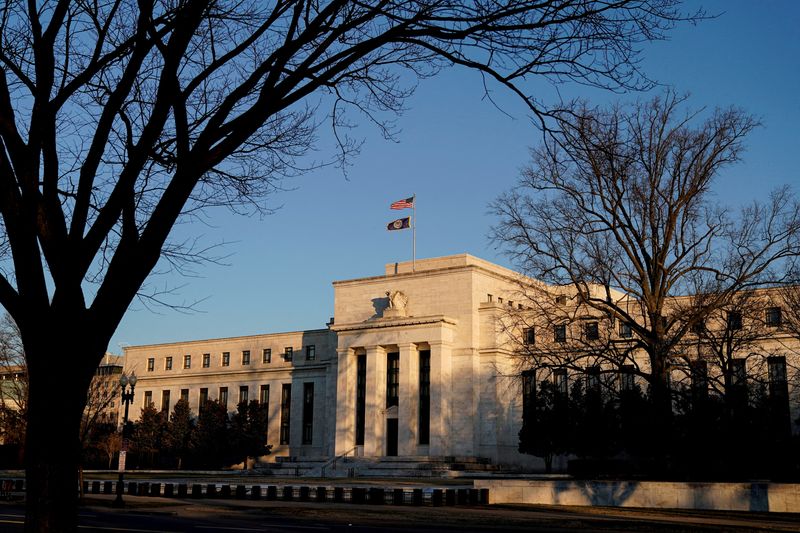By Michael S. Derby
NEW YORK (Reuters) - Borrowing at a key Federal Reserve facility long associated with providing emergency loans to banks has been edging higher, recently climbing to over $10 billion for the first time in more than two years, a development market participants are eyeing for signs it could herald trouble in the financial system.
For now, worries are low. Some even believe rising usage of what the Fed calls the Discount Window could show the waning of persistent stigmas that have long kept banks away from an easily accessible source of short-term loans.
That said, if borrowing continues to rise, it could signal trouble at a time when many are already worried very aggressive Fed rate rises might break something in the financial system. Rising usage could also mean financial sector liquidity is running short, which could cause the Fed to slow or bring an early stop to efforts to shrink the size of its balance sheet.
While it hasn’t been a straight line up, deposit-taking banks have collectively increased borrowing at the Discount Window since the start of the year, when it was at negligible levels. Since early November, borrowing has perked up and for the week ended Wednesday stood at $7.2 billion, down just under $3 billion from the prior Wednesday when it had topped $10 billion for the first time since early June 2020, Fed data released Thursday showed.
Current activity remains a shadow of where it was in recent periods of stress. In March 2020 at the onset of the coronavirus pandemic discount window borrowing surged to a peak of around $50 billion. Even that was less than half the $112 billion record in October 2008, during the most acute phase of the financial crisis.
Graphic: 'Discount Window' borrowing picks up at the Fed, https://www.reuters.com/graphics/USA-FED/BORROWING/byvrllodkve/chart.png
A JUMP IN BORROWING
Discount window borrowing is opaque by design, and firm conclusions are difficult to reach, analysts say. Total usage data is reported weekly, but banks taking the loans are only revealed with a two-year lag. The facility is open to deposit-taking banks and includes many small banks.
“There really shouldn't be a reason discount window borrowing is increasing at all,” said Thomas Simons, an economist with investment bank Jefferies. He noted that banks as a whole are very flush with cash, which ought to obviate the need to seeks short-term loans from the Fed, he said.
Simons said it’s possible borrowing could rise to $25 billion to $30 billion into the end of year with no implications for the health of the financial system. But if borrowing jumped up to $50 billion it “would really start to open my eyes and think that we’re entering a period of stress.”
Joseph Abate, an analyst at Barclays (LON:BARC), in a note to clients on Nov. 30, said the rise in borrowing is strange because it is “uneconomical” relative to other short-term funding options. The primary credit rate now stands at 4% against a federal funds target rate range of between 3.75% and 4%, and it costs more to borrow cash from the discount window than it would in some private markets.
“The increase in discount window borrowing may be a sign that funding pressures are building at the fringes of the market,” Abate wrote.
STIGMA ARRESTED?
Some see rising discount window usage in a more benign light, though, showing potentially that long-standing Fed efforts to encourage usage - and end the stigma associated with it - are bearing fruit.
"I would generally say it's not a bad thing. It's a good thing” because it means the Fed may be having success in reducing those stigma issues, said Bill Nelson, chief economist with industry group the Bank Policy Institute. A former top Fed staffer, Nelson worked on efforts to overhaul the facility nearly 20 years ago into its current form.
The Fed has for some time sought to tell banks it's fine to use the discount window given that it calms markets and helps monetary policy function. With this liquidity tool largely shunned, the Fed has been forced to come up with other lending facilities and has worried that they too might be avoided out of fears that tapping them could signal trouble for a bank and invite the attention of regulators.

Rising discount window borrowing might also have implications for the Fed's ongoing efforts to shrink the size of its balance sheet. The Fed is taking liquidity out of the financial system but will stop when it gets near a level that would cause short-term interest rates to become volatile.
If banks are starting to face liquidity constraints now it might signal reserve scarcity is arriving sooner than thought. That could force the Fed to slow or stop reducing what is now a $8.6 trillion balance sheet.